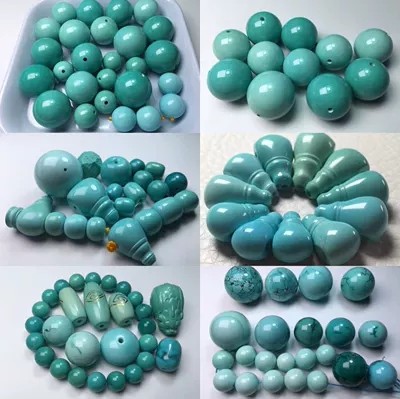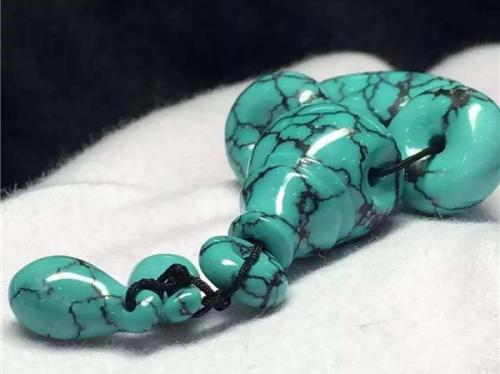Turquoise manufacturing process
Turquoise manufacturing process
The process requirements of turquoise are mainly based on color, texture, impurities and lumpiness. The ones with hard quality and blue color like porcelain pine, the big ones are special grade materials, and the small and medium ones are first grade materials; those with medium hardness and color ranging from blue to bean green, such as green pine and the beautiful wire pine, the larger ones are The first grade material, the medium and small pieces are the second grade materials; the other usable materials are the third grade materials; the last one is the "noodle" loose, which can only be used after large pieces or processing. The statue of "Li Shizhen Collecting Medicine" in the Hubei Hall of the Great Hall of the People is carved from turquoise. Turquoise jade carving handicrafts are one of China's unique export jade carving varieties, and enjoy a high reputation in the international market.

Modified turquoise
In order to improve the appearance and color of some poor-quality natural turquoise, improve durability and make it easy to be polished and not broken, methods such as wax injection and injection molding are usually used to modify natural turquoise. This approach is generally recognized by the jewelry industry, after all, there are too few high-quality turquoises. The main component of the modified turquoise is still natural, but it has undergone a modification process.
The commonly used modification methods are as follows: Wax injection-because turquoise is a kind of gem with relatively low density, wax injection can fill the tiny pores on the surface and avoid contamination of turquoise during wearing. This is turquoise processing. A very old craft in China. After waxing, the turquoise color will naturally become darker and more ornamental, and the color and texture will become clearer and beautiful. The turquoise of this craft is mostly used for jewelry inlays.
Zachery treatment method-can improve the color of turquoise, reduce porosity without adding any foreign substances. The treated turquoise shows a blue hue of "robin eggs". Turquoise treated by this method will have a relatively deep blue enrichment near the cracks. Advanced detection methods can find that the turquoise treated by Zachery has an abnormal increase in potassium.
However, the turquoise that has undergone an improved and optimized process, like the southern red agate and the Warring States red agate, will age over time. Therefore, this type of jade gemstone can be worn, but the value is greatly reduced and there is no collection value.

Synthetic turquoise
This kind of so-called turquoise has no natural turquoise [2] ingredients, and of course it has no natural spirituality. If you buy turquoise for spiritual energy, you must never buy this type of synthetic turquoise. Synthetic turquoise usually has the following types:
The Gilson method synthesis of turquoise uses the process of making ceramics. When you zoom in, you can see the blue particles distributed on the shallower substrate, which is commonly known as the phenomenon of "cheese sandwiching wheat". Synthetic turquoise has typical blue tiny particles, sometimes with artificial "iron wires" on the surface.
Dyed boromoleite is a cheap imitation of turquoise, and the simple way to identify it is to show pink under the Charles filter.
Glass can also be used to imitate turquoise, but the refractive index values of the two are significantly different. Whirlpools and bubbles can also be seen in the glass.
A mixture of mineral powders, dyed and cemented with plastic and epoxy resin, can also be made into turquoise imitations. Heating and pressure during the production process will produce fractures that can be seen by magnification.

Some people say that the one with iron wire is natural turquoise, and the one without iron wire is man-made. In fact, this kind of argument cannot stand scrutiny at all-if a small piece of natural turquoise is dug from the part that does not contain iron wires, isn't it natural? On the contrary, artificial turquoise is also easy to imitate the effect of iron wire. Therefore, the iron wire cannot be used as a standard for judging the authenticity of turquoise. However, Qingqing introduces to you an experience in identifying turquoise, which is also related to iron wire, that is: natural turquoise iron wire is often concave, while synthetic turquoise iron wire is generally not concave.
Generally speaking, high-quality high-quality turquoise that is suitable for polishing and not easy to break is very rare. Therefore, if you see turquoise bracelets polished into round beads or other specific shapes on the market, they will basically not be pure natural, but may be modified. , It may be artificially synthesized. Only some turquoise bracelets with natural irregular shapes and sunken wires can be basically judged as pure natural. In addition, there are some high-quality small pieces of pure natural turquoise, but it is also rare and expensive, so don't expect people to use this material to make bracelets. It is usually used to make rings, and there is no wire. You need to be extra careful when identifying.

Contact: :AnnaHe
Mobile/Wechat/WhatsApp : +86 13751114848
Contact :JeamChen
Mobile/Wechat/WhatsApp: +86 13425105392
Email: info@TurquoiseChina.com
Company address:
Room 1307 Tower A,Yanlord Dream Center,Longcheng Street, Longgang District, Shenzhen,Guangdong Province,China 518172
See the surprise, please consult our customers.


Become An Insider











































































































